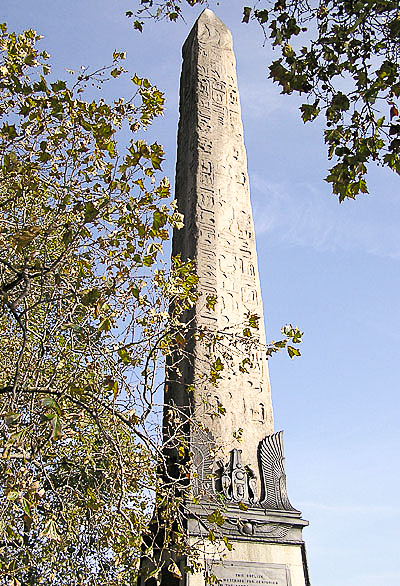One of my favorite sites in Paris (and I have many) is the Place de la Concorde. This giant roundabout has seen its share of historical events from the time of its inception in 1755 to the French Revolution in the late 18th-century and finally, the liberation of Paris from the Nazis in August 1944. Originally known as the Place Louis XV, it is easily recognizable by the two Fontaines de la Concorde based on a theme of rivers and seas, the sculptures representing eight French cities, and of course, the view up the Avenue des Champs-Élysées toward the Arc de Triomphe. However, once in sight of the Place, your eyes are immediately drawn to the tall obelisk standing in the center of the Place. The obelisk is more than three thousand years old and called the Luxor Obelisk. There is another famous obelisk standing in London and it is called “Cleopatra’s Needle.” For those of you who know your Egyptian history, you’ll immediately recognize that naming a 3,000-year-old obelisk after Cleopatra is misleading. I am sure that some people confuse the obelisks and might associate the Paris Luxor Obelisk with Cleopatra.


Did You Know?
Did you know that historical “transitions” don’t happen instantaneously? What I mean is that historical events aren’t simply turned on and off by a switch. A great example would be the rise and decline of the Roman Empire. When you ask, “When did the Roman Empire end?” the common response is 500 A.D. Well, it’s not like the Romans were out and the Huns were in at the stroke of midnight on 1 January 500 A.D. There were several hundred years over which the transition took place. The same could be said of the twentieth century’s Cold War, although it took much less time than the demise of the Roman Empire. We tend to think that once World War II was over, we immediately entered into the Cold War with the Soviet Union. While it didn’t take long before Truman and Churchill saw the conflict coming, it took the public quite a while to come to grips with the Soviet threat. Churchill’s famous “Iron Curtain” speech in March 1946 was criticized as being too hawkish and Truman was forced to distance himself from Churchill. The Soviet Union coup of Czechoslovakia in February 1948 established Communist control in that country for the next four decades. It also woke up the American public to Soviet global intentions and as a result, the Cold War was off and running. Today, could it be that a similar pattern with respect to China is beginning to emerge? Travelling through Southeast Asia recently, we saw first-hand the influence of China in that region of the world. It is spread far, and it is deep. With the exception of Singapore and Vietnam, the economies of the other countries we visited appeared to be heavily dependent on China and its vast investments. The Chinese have always taken a long-term approach to their goals. During the 1970s, Chinese Premier Zhou Enlai was once asked what he thought was the significance of the 1789 French Revolution ⏤ almost two hundred years earlier. He responded, “It’s too soon to tell.”
Egyptian Dynasties
A total of thirty-one Egyptian dynasties existed between 3100 B.C. and 332 B.C. (e.g., “1st Dynasty,” “2nd Dynasty,” and so forth). Preceding these between 3200 B.C. and 3100 B.C. was the “Predynastic Period” or “Dynasty 00.” After the 31st Dynasty ended in 332 B.C., the Hellenistic dynasty of Alexander the Great (332 to 309 B.C.) ruled Egypt followed by the Ptolemaic Dynasty (309 to 30 B.C.). The Cleopatra we all know and love was one of the last rulers before Egypt was absorbed into the Roman Empire. Read More “Cleopatra in Paris and Full-Frontal Baboons”




